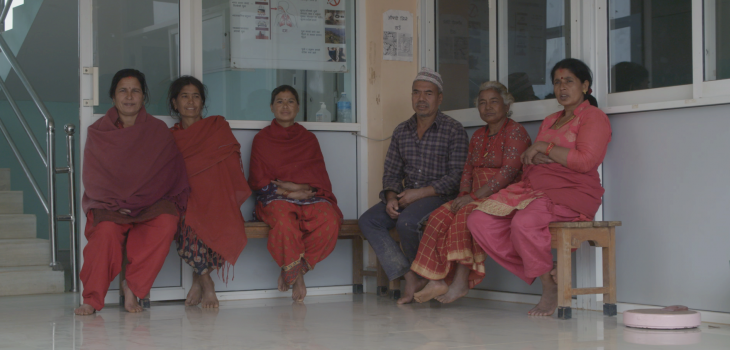By Manuela Colombini1 and Satya Shrestha2
1: Department of Global Health and Development, London School of Hygiene and Tropical Medicine, United Kingdom
2: Nursing and Midwifery Program, Kathmandu University School of Medical Sciences, Nepal
When we talk about domestic violence (DV), it is not just a private matter confined within the walls of a home. It is a prevalent, societal issue that demands urgent attention, especially within healthcare systems. Our ground-breaking comparative study HEalthcare Responding to violence and Abuse (HERA) project delved into the readiness of health systems across low- and middle-income countries (LMICs) to tackle DV. Health system readiness essentially focuses on how prepared health systems and institutions are, including providers and potential service recipients, to accept and implement the necessary changes to manage DV services. By adopting a health system readiness lens, we can unveil the intricate tapestry of barriers and opportunities in combating DV within healthcare settings. Readiness is not governed by isolated factors but rather by interconnections spanning across multiple dimensions and levels. Let’s explore the key findings and their implications from our recently published paper in Health Policy and Planning.
Are our health systems ready and equipped to address domestic violence?
The urgency of this question cannot be overstated. Many health systems are not fully equipped to provide quality care for women and girls who have experienced violence. Across diverse regions such as Brazil, Sri Lanka, Nepal, and the occupied Palestinian territory (oPT), socio-cultural landscapes vary significantly. However, amidst these diversities, one common thread emerges: preparedness and willingness of healthcare providers and service availability represent only one aspect of their health system readiness to address domestic violence. It is also greatly influenced by structural and organisational issues, such as values, governance, leadership, and the connections with survivors and communities.
Understanding the Realities: Socio-Cultural Factors at Play
Cultural norms, religious influences, legal frameworks, and socio-economic conditions intricately shape perceptions and responses to DV. These factors highlight the complexity within which healthcare systems operate, reflecting the need for a nuanced approach tailored to each context.
Policy Gaps: Where Legislation Falls Short
While Brazil demonstrates higher readiness levels due to robust DV legislation and policies, our study reveals a critical gap between policy and practice. Even with supportive legal frameworks in place, the lack of translation of policies into actionable guidelines and their transmission to frontline providers hamper effective DV management.
Leadership Matters: Nurturing Support from the Top Down
At the heart of effective DV response lies strong health leadership. Yet, across all settings in the study, low prioritization of DV at the policy level translates into resource constraints, unclear pathways of care, and inadequate training for providers. Without decisive action from health leadership, frontline staff are left unsupported and ill-equipped to address DV.
Empowering Providers: Soft Skills and Attitudinal Shifts
Providers’ motivation, empathy, and personal commitment emerge as key facilitators in DV response. However, traditional gender roles, beliefs and societal stigma surrounding DV persist, hindering provider engagement and women’s willingness to seek help. Addressing these barriers requires a shift towards gender-equitable attitudes and comprehensive provider training.
Towards Multi-Sectoral Collaboration: Breaking Down Silos
DV response cannot operate in isolation. Multi-sectoral coordination is paramount, yet challenges persist in collaborating with external agencies. Improved communication and feedback mechanisms are essential to enhance support services for DV survivors, bridging the gap between healthcare and other systems.
Engaging Survivors and Communities: Building Trust and Awareness
Women and community readiness is something that has often been overshadowed in health systems responses to DV. Low engagement of women and communities with health services for DV underscores the need for enhanced trust and awareness. Misconceptions about healthcare’s role in addressing DV, coupled with anticipated stigma and fear of judgement, pose significant barriers to women’s health seeking behaviours. Strengthening linkages between community and health-based services is essential to overcome these challenges.
Conclusion: A Call to Action
In confronting DV within healthcare settings, there is no room for complacency. Policy clarity, leadership support, provider empowerment, multi-sectoral collaboration, and women and community engagement are all critical components of an effective response. By addressing readiness challenges head-on, we can create safer, more supportive environments for DV survivors worldwide. The journey towards fostering health systems readiness for DV response in LMICs is fraught with challenges yet brimming with potential. By embracing a holistic paradigm that integrates policy, practice, survivors and community perspectives, we can pave the way for a future where every survivor receives the support, care, and justice they deserve.
Join the Conversation: What makes a health system ‘ready’ to address domestic violence? Share your thoughts below.
Read more about the study here.
Image credit: ‘Photo from HERA film with permission of Saul & Josh Studio’.











